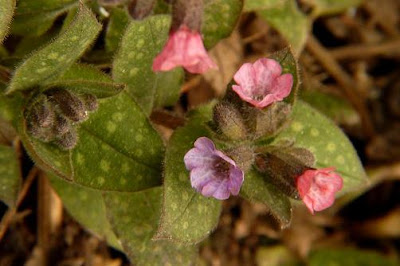 Lesser Celendine, Ramunuculus ficaria
Lesser Celendine, Ramunuculus ficariaAt the start of the new year, everyone is eagerly waiting for the first green leaf, sprout, or any other sign that life in the garden has started again, hence the people here talking of The Coming of the Green.

Like in the previous months, the Blackbird was still present in every field, hedgerow, trees and gardens that I passed. And Blue Tits were singing everywhere. Did they also have spring in their little minds? Were they looking for probable nest sites, already? And shouldn't all those Blackbirds not be returning back to the continent? Or are they waiting for the right wind? The present southern galeforce wind is not very helpful when you need to fly east.
Ferns too, are celebrating the arrival of spring. The spores at the underside of their leaves, are their way of propagating when the spores are travelling on the wind, to settle and germinating in a new place. I'm afraid that most of these spores will end up in the river below the bridge, although the galeforce winds of the last few days might well have stolen some in its grip.
Ferns too, are celebrating the arrival of spring. The spores at the underside of their leaves, are their way of propagating when the spores are travelling on the wind, to settle and germinating in a new place. I'm afraid that most of these spores will end up in the river below the bridge, although the galeforce winds of the last few days might well have stolen some in its grip.

And these I found further on the road. It surprised me that this flower of another Lesser Celendine, had opened fully already. It was growing in a very dark corner. The trees above it casting a dark shadow over it, and the Sun not, or hardly ever, being able to reach it.

The banks of the river, cleared of the invasive Gunnera or Giant Rhubarb, Gunnera tinctoria.

Lichen was also settling onto the bridge. And a few bits of Moss too.

As is the Woodsorrel, Oxalis acetosella.

These lovely little flowers I have not seen before, and I suspect that the owner of the house behind the fence, has planted these themselves, or that it is a garden escape. Any suggestions are very welcome.


The Wild Ivy, Hedera helix, does not show that many left over berries any more. Despite birds preferring to feed on red or orange berries, this winter they had to eat whatever they could find.

This tiny flower I find at the rectory, underneath the row of Sweet Chestnuts. It was spread out over about a metre or more, but I could not find its ID yet. Any clues are welcome.
The unopened flower bud reminded me of the days I was rolling my own tobacco. It just looks like a rolled cigarette paper.:


 Dandelion.
Dandelion.I found this leafmine on some Bramble leaves from last year, and the leaf reminded me of photos of a leafmine which I'd seen on Stuart's wildlife blog, Donegal Wildlife, in his post, Still snowy.
I think that this is the Leafmine, Stigmella aurella.

I am not sure if it is the same Leaf mine, as the one Stuart saw on his walk, but I like what he says about them:
"Leaf-miners are always worth a look: the plant they live on, can be a very strong clue to species, and it is interesting to see the different strategies they use to avoid falling out of the leaf.
Mines are made of species of Flies, Sawflies, Micromoths and Weevils. The shape of the mine can usually tell us to which family a particular mine belongs"


No comments:
Post a Comment
Thank you for visiting Wildlife on Wheels; Feel free to leave your comments; it is very much appreciated.
Yoke.